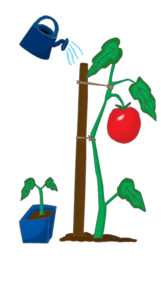A recent trend in America has been a return to backyard food gardens. With vegetable prices on the rise and a growing desire for organic produce, backyard farming is seen as a viable alternative to purchasing from the supermarket.
“We don’t use a lot of pesticides because a lot of the kids that are coming up now are allergic to that stuff and get sick,” Agriscience teacher Gale Brickhouse said. “A lot of parents and a lot of people try to grow their own fruits and vegetables to eat.”
This guide will help you with a few tips and tricks to make your backyard garden as productive as possible.
Getting started: It’s important to start small. Don’t take on more than you can handle. It’s best to consider how many vegetables you can actually use. You can always expand the garden later. Know how much space you will have for the garden, and plan accordingly. Is your backyard shaded or in direct sunlight? Research what plants grow well in the amount of sunlight y ou have.
ou have.
Seedlings: Young plants are vulnerable to shifts in the weather, pests and other problems. A good way to protect them is to use a transplant system. These kits come with seeds in their own pre-portioned soil plugs inside of a plastic box, which helps maintain optimal conditions. Keep the kit inside and care for it until the seeds have sprouted and grown to sufficient size to be transplanted outside. This protects the seedlings during some of their most vulnerable times. These kits can be bought in most garden supply stores and hardware stores.
Soil: One of the most important parts of a garden is the soil. The clay heavy soil found in the region means much care needs to be taken in making sure plants have the proper nutrients they need. Premade soil mixes work fine, but a cheaper and more effective method is to start a compost pile. Collecting food waste and kitchen scraps and allowing them to compost can be a great source of nutrient rich soil for your garden. Just be sure to avoid composting any fruits or vegetables with seeds. You don’t want to introduce any unwanted plants into your garden.
Cohabitation: Raising small livestock and poultry, such as chickens, is a great way to not only get your own eggs and other goods, but also to benefit your garden. You can use the nitrogen rich manure from animals as natural fertilizer to help keep your plants healthy. Poultry also eat pest insects which can harm your plants or yourself. Just be sure to have a tall enough fence to keep your livestock from snacking on your garden.
Fencing: A high fence is critical to maintaining a healthy garden. Due to the removal of wolves and other large predators from our local ecosystem years ago, the deer population in the area has skyrocketed, and deer love to graze in gardens. Without adequate fencing, you could see an entire season’s worth of produce gone overnight. It’s not just deer, but also squirrels, raccoons, rabbits and even neighborhood dogs that want to munch on your hard work.
Watering: Different plants require all different levels of water. Make sure you know how much your plants need so you don’t drown them or kill them with thirst. Automated sprinkler systems can help, but they waste a lot of water. Just going out with a hose and making sure you’re as accurate as possible goes a long way towards saving water. Other systems, such as a rain collection barrel hooked up to your gutters and drip irrigation, can save you a lot of money watering your garden.
Weeding: This is everybody’s least favorite part of gardening, but you have to do it. Weeds will shade out your plants and compete with them for precious nutrients. When weeding, it is important to remove the root system as well as the aboveground portion of the weed. Most weeds can grow back from just the roots. You can help prevent the growth of weeds from growing by putting down landscaping fabric, which blocks the weeds from getting sunlight. Newspaper can also be used, which has the benefit of being biodegradable.
Support: Making sure your plants have the adequate support needed to grow tall and healthy is very important. Especially for plants such as tomatoes, proper staking and support is key. Otherwise, the plants will sag under the weight of their own produce, potentially killing the plant.
Harvesting: When it comes time to harvest the fruits of your labor, it is important to be careful with your plants. Oftentimes, a plant will become ready for harvest over time, with some of its fruits or vegetables becoming ripe before others. Because of this, you have to be careful not harm any of the other growths when you are harvesting. Cutting the vegetable off the plant as close as you can to the vegetable is very important.

